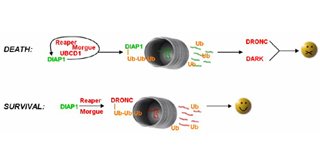
The mechanisms of DRONC and DIAP1 degradation. Adapted from Martin, 2002. (Image courtesy of Kate Stafford. Used with permission.)
Instructor(s)
Prof. Christopher Burge
Prof. David Sabatini
Dr. Marilee Ogren-Balkema
Dr. Alice Rushforth
MIT Course Number
7.16
As Taught In
Spring 2005
Level
Undergraduate
Course Description
Course Features
Course Highlights
This course features lab protocols and notes on scientific communications.
Course Description
The course applies molecular biology and reverse genetics approaches to the study of apoptosis, or programmed cell death (PCD), in Drosophila cells. RNA interference (RNAi), or double stranded RNA-mediated gene silencing, will be used to inhibit expression of candidate apoptosis-related genes in cultured Drosophila cells. Teams of 2 or 3 students will design and carry out experiments to address questions about the genes involved in the regulation and execution of PCD in this system. Some projects involve the use of DNA damaging agents or other cytotoxic chemicals or drugs to help understand the pathways that control a cell's decision to undergo apoptosis. Instruction and practice in written and oral communication are provided.


